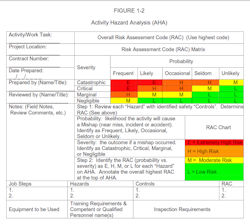30.A.17 Activity Hazard Analysis (AHA).
An AHA represents the dive team's best effort to anticipate and mitigate or prevent the adverse effects of equipment failure, extreme weather and environmental conditions, or other hazardous/unexpected situations.
- AHA's must address risk to personnel, property and to impacts to the overall USACE mission. When required, a new AHA must be conducted to reflect changes in site conditions, operational changes, etc.
- Each AHA will be job specific and address each phase of work, to include the hazards associated with flying after diving.
- For USACE dive teams, a Risk Assessment Code (RAC) must be applied to all underwater diving activities, with residual risk being approved by the appropriate level of command.
- Hazardous Energy Control (HEC) procedures in accordance with Section 12 of this manual and procedures for dealing with differential pressures will be included if appropriate.
- (1) If HEC procedures are required for the diving operation, the diving supervisor will visually check all lockout/tagout and other control procedures/devices to assure they are in place and redundant where possible prior to the commencement of the diving operation.
- (2) A copy of any clearances/permits to be issued to deal with identified hazards will be attached to the AHA.
- Some dives may be sufficiently complex to warrant several separate analyses.
- The AHA will be covered in detail at the pre-dive conference.
30.A.18 Emergency Management Plan.
An emergency management plan will be prepared for each dive operation. The minimum content of the plan will be as follows:
- Location and phone number of nearest operational recompression chamber if not located at the dive site and the Divers Alert Network (DAN) phone number (919-684-9111);
- Location, directions to and phone number(s) of nearest hospital(s) or available physicians capable of treating dive injuries;
- Location and phone number of nearest USCG Rescue Coordination Center, where appropriate;
- Description of an emergency victim transport plan including phone numbers of appropriate emergency transport services;
- Procedures and phone numbers or other means of communications to activate emergency services at the facility where the work is being performed;
- Diver rescue procedures conducted by the dive team, including responsibilities of team members, best location(s) where injured divers may be removed from the water, and best location(s) for performing first aid/stabilization prior to emergency medical assistance arrival.
Knowledge Check Choose the best answer for the question.
30-7. Each diving operations Activity Hazard Analysis (AHA) must _____.
You forgot to answer the question!


